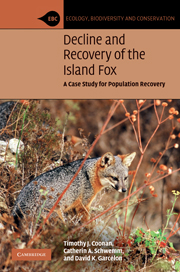Book contents
- Frontmatter
- Contents
- Foreword
- Acknowledgments
- 1 Introduction
- 2 Evolution and genetics
- 3 Social structure, reproduction, mortality and survivorship, and population dynamics
- 4 Food habits, habitat use, activity patterns, and dispersal
- 5 Golden eagles and the decline on the northern islands
- 6 Ecosystem recovery
- 7 Disease and decline on Santa Catalina Island
- 8 Recovery actions
- 9 Recovery actions
- 10 Reproductive biology, by Cheryl Asa
- 11 Diseases of island foxes, by Linda Munson
- 12 Zoos, education, and public participation
- 13 Managing recovery
- 14 The ecological role of island foxes
- 15 Conclusion
- References
- Index
12 - Zoos, education, and public participation
Published online by Cambridge University Press: 05 October 2010
- Frontmatter
- Contents
- Foreword
- Acknowledgments
- 1 Introduction
- 2 Evolution and genetics
- 3 Social structure, reproduction, mortality and survivorship, and population dynamics
- 4 Food habits, habitat use, activity patterns, and dispersal
- 5 Golden eagles and the decline on the northern islands
- 6 Ecosystem recovery
- 7 Disease and decline on Santa Catalina Island
- 8 Recovery actions
- 9 Recovery actions
- 10 Reproductive biology, by Cheryl Asa
- 11 Diseases of island foxes, by Linda Munson
- 12 Zoos, education, and public participation
- 13 Managing recovery
- 14 The ecological role of island foxes
- 15 Conclusion
- References
- Index
Summary
In some ways protected islands are exceedingly good places to implement rare species recovery; restricted human access nearly eliminates direct impacts (e.g. poaching or illegal hunting), while the absence of adjacent lands reduces inputs that degrade habitat or hinder population growth (Janzen 1986). However, species isolation also limits opportunities for most people to see and interact with plants and animals, weakening the emotional connection that leads to support for recovery programs (Solomon 1998, Restani and Marzluff 2002, Rabb and Saunders 2005). Until recently relatively few people had ever seen an island fox or were familiar with the species (K. Dearborn, Friends of the Island Fox, personal communication). When it was apparent that several subspecies of island foxes faced extinction, the need to increase public awareness and gain support for risky and sometimes controversial recovery actions became a priority. The goal of successfully educating the public in a relatively short period of time fell to citizen advocates, zoos, and environmental educators, and a chronicle of recovery would be incomplete if it did not include the important contributions made to incorporate the public as much as possible within the island fox recovery program.
Public advocacy
The first efforts to increase public awareness of island foxes were undertaken by a unique environmental group organized and run by children. In 1999 Alexandra Morris was a third grader whose father was an archeologist at Channel Islands National Park.
- Type
- Chapter
- Information
- Decline and Recovery of the Island FoxA Case Study for Population Recovery, pp. 144 - 153Publisher: Cambridge University PressPrint publication year: 2010



